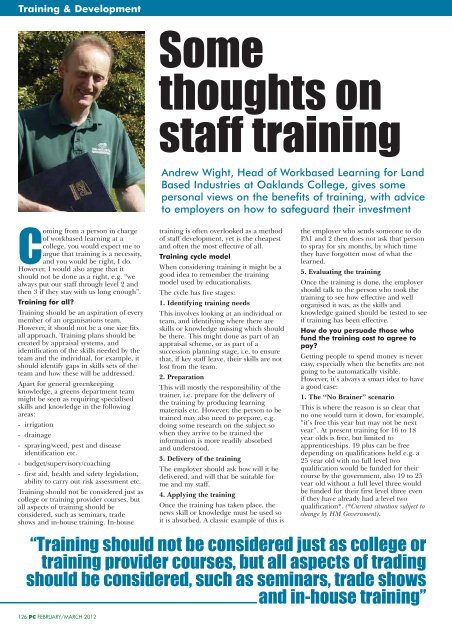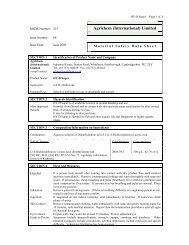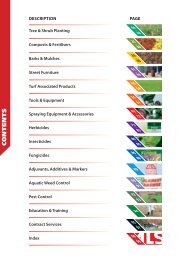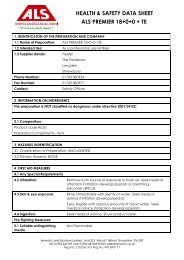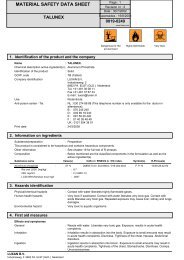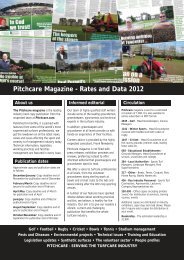these Open Championship Clubs choose to relief grind - Pitchcare
these Open Championship Clubs choose to relief grind - Pitchcare
these Open Championship Clubs choose to relief grind - Pitchcare
You also want an ePaper? Increase the reach of your titles
YUMPU automatically turns print PDFs into web optimized ePapers that Google loves.
Training & Development<br />
Coming from a person in charge<br />
of workbased learning at a<br />
college, you would expect me <strong>to</strong><br />
argue that training is a necessity,<br />
and you would be right, I do.<br />
However, I would also argue that it<br />
should not be done as a right, e.g. “we<br />
always put our staff through level 2 and<br />
then 3 if they stay with us long enough”.<br />
Training for all?<br />
Training should be an aspiration of every<br />
member of an organisations team.<br />
However, it should not be a one size fits<br />
all approach. Training plans should be<br />
created by appraisal systems, and<br />
identification of the skills needed by the<br />
team and the individual, for example, it<br />
should identify gaps in skills sets of the<br />
team and how <strong>these</strong> will be addressed.<br />
Apart for general greenkeeping<br />
knowledge, a greens department team<br />
might be seen as requiring specialised<br />
skills and knowledge in the following<br />
areas:<br />
- irrigation<br />
- drainage<br />
- spraying/weed, pest and disease<br />
identification etc.<br />
- budget/supervisory/coaching<br />
- first aid, health and safety legislation,<br />
ability <strong>to</strong> carry out risk assessment etc.<br />
Training should not be considered just as<br />
college or training provider courses, but<br />
all aspects of training should be<br />
considered, such as seminars, trade<br />
shows and in-house training. In-house<br />
126 PC FEBRUARY/MARCH 2012<br />
Some<br />
thoughts on<br />
staff training<br />
Andrew Wight, Head of Workbased Learning for Land<br />
Based Industries at Oaklands College, gives some<br />
personal views on the benefits of training, with advice<br />
<strong>to</strong> employers on how <strong>to</strong> safeguard their investment<br />
training is often overlooked as a method<br />
of staff development, yet is the cheapest<br />
and often the most effective of all.<br />
Training cycle model<br />
When considering training it might be a<br />
good idea <strong>to</strong> remember the training<br />
model used by educationalists.<br />
The cycle has five stages:<br />
1. Identifying training needs<br />
This involves looking at an individual or<br />
team, and identifying where there are<br />
skills or knowledge missing which should<br />
be there. This might done as part of an<br />
appraisal scheme, or as part of a<br />
succession planning stage, i.e. <strong>to</strong> ensure<br />
that, if key staff leave, their skills are not<br />
lost from the team.<br />
2. Preparation<br />
This will mostly the responsibility of the<br />
trainer, i.e. prepare for the delivery of<br />
the training by producing learning<br />
materials etc. However, the person <strong>to</strong> be<br />
trained may also need <strong>to</strong> prepare, e.g.<br />
doing some research on the subject so<br />
when they arrive <strong>to</strong> be trained the<br />
information is more readily absorbed<br />
and unders<strong>to</strong>od.<br />
3. Delivery of the training<br />
The employer should ask how will it be<br />
delivered, and will that be suitable for<br />
me and my staff.<br />
4. Applying the training<br />
Once the training has taken place, the<br />
news skill or knowledge must be used so<br />
it is absorbed. A classic example of this is<br />
the employer who sends someone <strong>to</strong> do<br />
PA1 and 2 then does not ask that person<br />
<strong>to</strong> spray for six months, by which time<br />
they have forgotten most of what the<br />
learned.<br />
5. Evaluating the training<br />
Once the training is done, the employer<br />
should talk <strong>to</strong> the person who <strong>to</strong>ok the<br />
training <strong>to</strong> see how effective and well<br />
organised it was, as the skills and<br />
knowledge gained should be tested <strong>to</strong> see<br />
if training has been effective.<br />
How do you persuade those who<br />
fund the training cost <strong>to</strong> agree <strong>to</strong><br />
pay?<br />
Getting people <strong>to</strong> spend money is never<br />
easy, especially when the benefits are not<br />
going <strong>to</strong> be au<strong>to</strong>matically visible.<br />
However, it’s always a smart idea <strong>to</strong> have<br />
a good case:<br />
1. The “No Brainer” scenario<br />
This is where the reason is so clear that<br />
no one would turn it down, for example,<br />
“it’s free this year but may not be next<br />
year”. At present training for 16 <strong>to</strong> 18<br />
year olds is free, but limited <strong>to</strong><br />
apprenticeships. 19 plus can be free<br />
depending on qualifications held e.g. a<br />
25 year old with no full level two<br />
qualification would be funded for their<br />
course by the government, also 19 <strong>to</strong> 25<br />
year old without a full level three would<br />
be funded for their first level three even<br />
if they have already had a level two<br />
qualification*. (*Current situation subject <strong>to</strong><br />
change by HM Government).<br />
“Training should not be considered just as college or<br />
training provider courses, but all aspects of trading<br />
should be considered, such as seminars, trade shows<br />
and in-house training”


